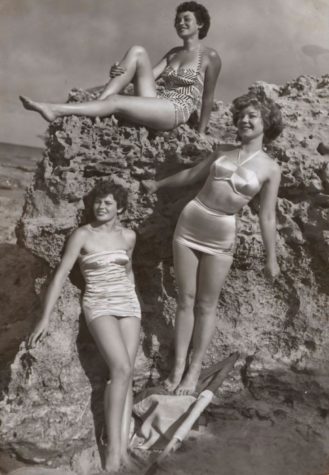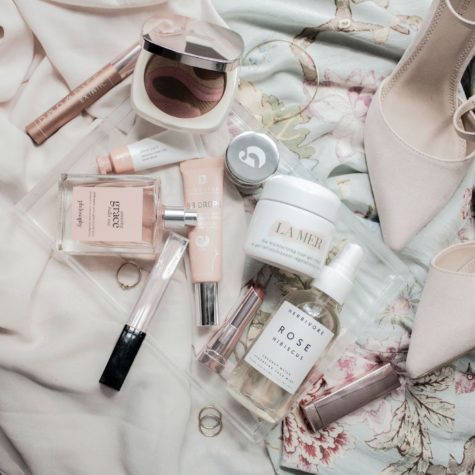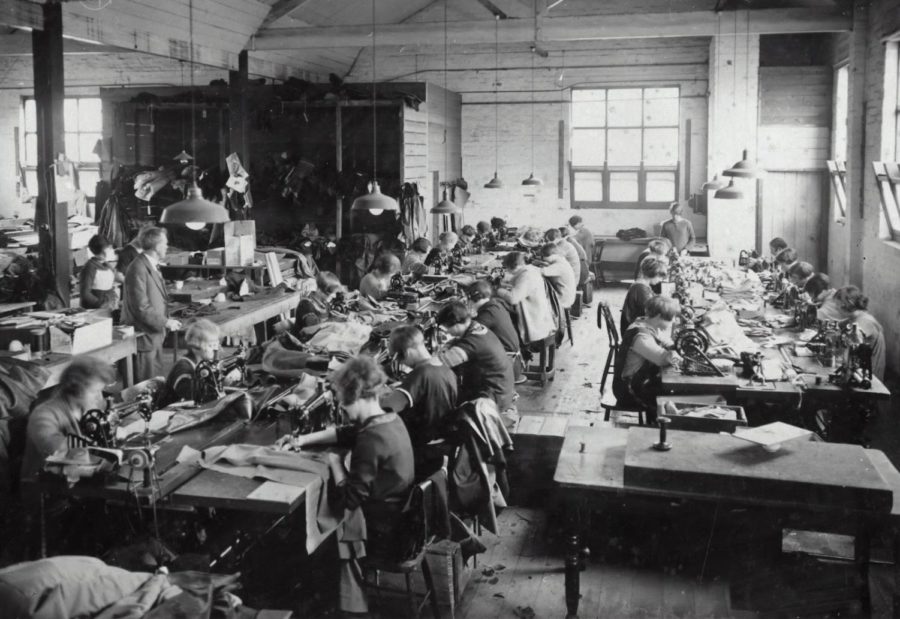Women As the Force Behind Capitalism
Without women, capitalism would not exist
Workers in a twentieth- century factory produce garments.
When people think of capitalism, they think of laissez-faire economics, of an industry that depends on private owners, of a system that promotes rugged individualism and making a profit. But most people would not immediately think that women are the driving force behind capitalism; the workers who labor in factories to create products such as textiles, and the consumers who are targeted by companies that create new beauty standards in order to sell products.
With the beginning of the Industrial Revolution came a revolution for women, whose roles shifted from being centered around the home to working in factories. Working-class women entered the workforce to support their families, but they were underpaid, especially in comparison to men. Women faced discrimination and harassment, and they were subject to dangerous working conditions. They were also expected to return home to care for their children and husbands at the end of a long workday. Many women who worked in factories were immigrants; they did not speak English and were therefore taken advantage of by factory owners.
A prime example of this is the Triangle Shirtwaist Factory. Most of the workers were teenage female immigrants who worked twelve hours a day and did not speak English. To cut costs, workers were severely underpaid, and the factory owners took no precautions to make sure their workers were safe.
The Triangle Shirtwaist Factory is most famous for its fire in 1911. 146 people were killed in the fire, most of the victims being young girls. Some died directly from burns or smoke inhalation, but the majority died from jumping from great heights to escape the fire. Many of these deaths were preventable; if the owners had taken steps to ensure that there were proper fire escapes and evacuation plans, the death toll could have been much lower.
Despite evidence that the owners had been negligent, they were not indicted in the aftermath of the fire. They paid $75 to each victim’s family, yet were paid $400 for each death by their insurer. Even in tragedy, the factory owners were still able to make a profit.
Furthermore, women played particularly important roles during World War II. They took jobs in the armed forces and the defense industry, so that men could fight. The iconic ‘Rosie the Riveter’ campaign was created to recruit women to work in American industries during World War II, when male enlistment left large numbers of industrial jobs open. Women served in a number of roles that were crucial to America’s success in the war. The majority of women wanted to keep their jobs after the end of the war, but were forced out because there was no longer a need for mass production, and men returned home to fill the jobs that women wanted to keep. Those women who continued to work were not paid the same salary as their male peers, and were often demoted to allow men to take the more powerful positions.
In addition to serving as a large part of the workforce, women also accounted for a large portion of consumer spending, particularly as companies targeted women by creating unrealistic beauty standards that served to profit corporations. One industry that took advantage of women was the razor industry.
At the beginning of the 20th century, it was rare for women to care about leg or underarm hair. Dancers and actresses used depilatory creams, but the fashion of the time was conservative enough that most women did not remove their body hair. As sleeveless dresses became more popular and hemlines began to rise, depilatory cream companies began to promote the idea that body hair was bad.

Gillette also capitalized off of new fashion trends after creating its first women’s razor in 1915. In an effort to expand their market from only including men, they claimed that body hair on women was masculine and unhygienic. They emphasized that women should feel embarrassed if they have body hair, and targeted the idea of the ‘Modern Woman’– if women did not use their safety razor to remove their body hair, they would be left behind and stuck in old times.
Gillette was careful not to use the word ‘shaving’ when talking about getting rid of female body hair and instead told women to make their bodies ‘smooth.’ In one advertisement, they claimed that “Gillette is welcomed by women everywhere– now that a feature of good dressing and good grooming is to keep the underarm white and smooth.” In this advertisement, they encouraged this new beauty standard– women must shave their underarms to be considered clean and fashionable– and simultaneously avoided using rhetoric that was typically associated with men. They feared that using the word ‘shave’ would discourage women from using razors.
It looked like shaving and depilatory creams would be just another fad, but by the early 1960s, almost all women between the ages of 15 and 44 were removing body hair. Advertisers wanted to make sure all women shaved, so they created advertisements specifically to scare women into shaving.
Magazines were a popular source for spreading the latest trends, so when they began to promote the removal of body hair, women quickly started to believe in its importance.
During World War II, there was a nylon shortage, meaning that many women were not able to wear stockings. More women removed body hair so that they could be bare-legged, providing sales boosts to razor and depilatory companies. The first electric razor for women was also sold, which made the shaving process much faster.
As shaving became normalized for women, advertisements used language that specifically associated shaving with femininity. In the 1980s, razor advertisements focused on encouraging women to shave to make themselves more appealing to men. From the 1990s to the 2000s, shaving advertisements shifted to focus on the importance of keeping the whole body hairless. This was a response to new fashion trends – bikinis became more popular, and clothing continued to become more revealing.
In the modern day, shaving is normal for women, and razors, like many other products, are subject to the “pink tax,” meaning that women pay much more for razors than men do.
Beauty standards that fuel the objectification of women, particularly in the media, lead to eating disorders and violence against women. Corporations target women to encourage them to spend money to fix their ‘flaws,’ which are often normal body parts that do not need to be changed. They encourage consumers to strive to achieve the “perfect body,” by telling women that they need to lose/gain weight to fit with the ideal body type of the time period. This has fueled generations of women who rely on the beauty industry to hide their “flaws.”
In an editorial on the unrealistic beauty standards that women encounter, Savanna Briscoe writes, “Most of the women I know always feel the need to cover up any noticeable flaw on their body or face. Women have been made to feel dirty or unfeminine if they don’t hide their blemishes.” By creating an unrealistic, unachievable beauty standard, companies have a growing market to supply them with profit. And, inevitably, no one ever achieves that beauty standard, so women are left chasing after an unattainable ideal image.

The exploitation of female factory workers has not been left behind in the 20th century. Female garment workers in Asia are still being threatened and abused; the corporations they work for want them to work at an unrealistic rate to support the fast fashion industry. This industry intentionally creates clothing of cheap quality to fit the latest trends so that when those trends go out of style, consumers are forced to buy new, “trendy” clothing all over again. Many cases of women being exploited are not reported out of fear, and some women are even physically harmed for not meeting production quotas, or not working fast enough. Sexual abuse is also prevalent in these factories, and women are punished when they try to speak up.
This discrimination against women does not exclusively happen in foreign countries, though; within America, mothers are harmed by the lack of paid maternity leave, the lack of breastfeeding accommodations, and discrimination against those who need to take care of family. Paid maternity leave allows women to return to the workforce and be more productive with the guarantee of financial stability, but corporations strive to cut costs as much as possible, and time off is therefore unregulated.
There has, however, been some improvement in the way that women are treated, particularly as women begin to reclaim their choices. Many women now choose not to shave, compared to previous generations, where a strong majority of women shaved regularly. Some people choose a specific rebellion against the shaving industry, which has long profited from targeting women. Others choose not to shave simply because they do not want to remove their body hair.
The media has also begun to back down from traditional beauty standards. Harper’s Bazaar, the first magazine to push the idea that body hair is unwomanly, recently published an issue that pictures a woman with body hair. This is a complete turnaround from the 20th century, when the same company heavily promoted shaving for women in all of its advertising.
We still have a long way to go; women still continue to be targeted by the beauty industry and do not receive fair working conditions and equal pay. However, thanks to women who have begun to reclaim their rights to choose what they look like, people have begun to question beauty standards. And, as we continue to discuss the need for equal pay and paid leave, we move towards a society that recognizes and appreciates the role that women play in supporting the economy.
“Most of the women I know always feel the need to cover up any noticeable flaw on their body or face. Women have been made to feel dirty or unfeminine if they don’t hide their blemishes,” said Savanna Briscoe.
Orli Strickman is an Arts and Entertainment Editor for ‘The Science Survey.’ She seeks to represent stories that do not receive a lot of mainstream...











